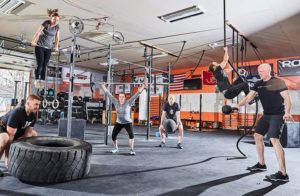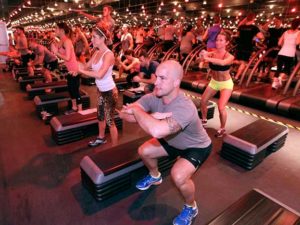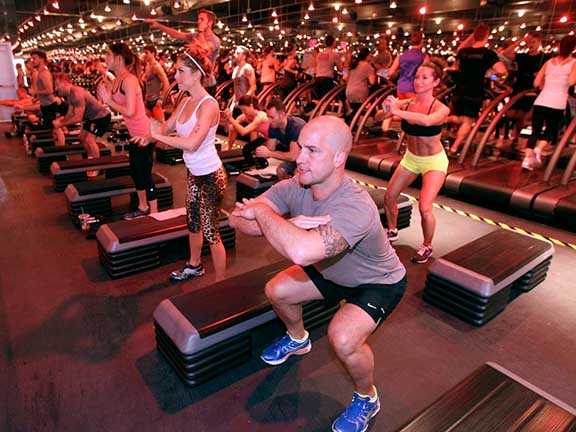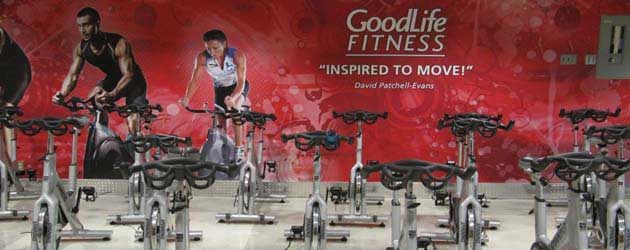The Noise & Vibration Challenges of Fitness Centers in High-Density Neighborhoods

How to Avoid Noise Complaints in Fitness Facilities: Acoustical Design and Mitigation Best Practices
The growing inclination towards a healthy lifestyle is driving health and fitness club market growth in the developed world. In urban centers, this expansion has accelerated at a rapid pace with gyms, fitness and health clubs now looking to open in locations once considered incompatible from an acoustic perspective.
What was once an industry reasonably separated from neighboring offices and homes, the fitness center world has been forced to adapt to customer demands for “around the corner” club availability in a very competitive business environment and an increasingly high-density urban landscape. This has meant more and more clubs taking occupancy immediately above, below, or adjacent to noise-sensitive commercial or residential spaces. If not properly anticipated and addressed in a new space’s design, fitness club activity-related sound and vibration can end up travelling through walls, floors, and ceilings within a building and impact not just directly adjacent neighbors, but spaces well across a common floor footprint, or even several floors away! The consequence? More noise and vibration complaints. More litigation. More headaches and unforeseen costs for club owners and property managers to contend with.
 The acoustical challenges of fitting-out gyms next to noise-sensitive spaces
The acoustical challenges of fitting-out gyms next to noise-sensitive spaces
In general, fitting-out gyms next to noise-sensitive spaces is challenging. The nature of synchronized, rhythmic activities such as running on treadmills, group fitness, or impulses such as dropped weights, requires a combination of an adequately stiff base floor, plus appropriate isolation of the working floor to prevent vibration transmission. Additional isolation may be further required of both structural and airborne paths of the associated sound, predominantly music and amplified vocal coaching. Often times, these requirements involve extensive structural upgrades to the space and are thus cost prohibitive. As well, the ideal approaches often conflict with other constraints of the tenancy (accessibility, ventilation, space, etc.).
In addition to the general challenges with gym fit-outs, there are often more specific challenges associated with a project, such as proximity to sensitive spaces, or a full-spectrum audio system with sub-woofers, which in turn produce loud, low-frequency sound; this type of sound tends to transmit easily across inadequately isolated or contained spaces. Codified acoustical requirements into the lease agreements can further increase the importance of adequate insulation and isolation of the noise and vibration.
 Fitness club noise and vibration issues leading to neighbor complaints
Fitness club noise and vibration issues leading to neighbor complaints
There are several types of noise and vibration issues which can lead to neighbor complaints. These include quick and unpredictably intermittent impact noise from weight drops, whether it be hand weights, human body weight, or weight machines. Other common issues include complaints about amplified music or speaking (from fitness instructor shout-outs), sometimes limited to the low-frequency bass rhythm, but other times inclusive of the high frequency harmonics and lyrics. In one extreme instance, HGC measured noise levels of music in a condo resident’s master bedroom during a 5:45 am fitness class directly below. The penetrating noise was so clear and loud that a music ID app on an iPhone held in the suite could clearly identify each song being played during the fitness class.
Many lease agreements now include maximum sound and/or vibration level criteria that a new gym owner must meet to in order to operate. This can only be achieved through engineered acoustical design considerations and implementations. Failure to incorporate acoustical mitigation best practices at the onset can quickly lead to complaints, litigation, and if not resolved, can force a gym owner to close or relocate.
 The best time to bring in a noise and vibration consultant
The best time to bring in a noise and vibration consultant
When is the best time is to bring in an acoustical consultant? As early as possible! This answer should hopefully not be a surprise given what we’ve already established earlier in this article. In general, the later that an acoustical consultant is brought into a project, the more likely technical and structural limitations will limit the range of cost-effective noise mitigation design recommendations that can be proposed. At a late stage of construction, or once a facility is in operation, the only noise and vibration mitigation solutions that may be viable are likely to be very expensive to implement, and as a result may therefore be infeasible for many gym owners to consider. Other noise mitigation options that can be considered involve compromises, that might not allow a gym to operate in its current or intended use, or time of day.
As an example, HGC was asked by a property manager to investigate a residential owner’s noise complaints. The owner’s suite was directly adjacent to a condo amenity gym. The gym was initially acoustically designed to accommodate light recreational fitness activities and included only a couple of installed treadmills, but then the condo’s property management expanded the facility to include more extensive and intensive fitness equipment including large barbells, battling ropes, and heavy medicine balls. After our investigation, in which we considered the size and location of the gym relative to suites in the building, as well as the structure of the condo building itself, we concluded that, while theoretically possible, there was no practical, cost-effective solution to adequately address vibration transmissions from the existing equipment in the gym to the complainant’s suite. As a result of our findings, the condo corporation was left with no choice but to remove all the heavier-grade equipment, and downsize the gym back to its originally intended light use.
Fortunately, this kind of compromising resolution is the exception and not the rule. In most cases, an acoustical consultant can come in, take sound and vibration measurements of typical activities in the facility, as well as at nearby sensitive spaces, and provide a range of cost-effective design recommendations to reduce sound and vibration transmission.
 How to mitigate noise and vibration problems in a gym or fitness club
How to mitigate noise and vibration problems in a gym or fitness club
The how depends first and foremost on the intended use of each fitness facility, as well as the location of the nearby sensitive spaces relative to where we want to address sound and vibration transmission. In some cases, a good 25 mm thick rubber floor is expected to be sufficient; although take note that not all rubber floors are equal.
An acoustical consultant will carefully consider heavy weight drop measurements or impact insulation class (IIC) test data when selecting the type of flooring, as well as sound transmission class (STC) test data, if applicable. Where comparable test data between different products is not available, we will often conduct field mock-up tests with samples of different types of flooring, with measurements in the nearby sensitive spaces, to ensure that selecting a type of flooring with less test data does not leave the client as exposed to risk of poor performance.
In other cases, where there are extremely loud spaces (such as a spin/rowing studio) or spaces that have very high levels of generated vibration (such as from an Olympic class weight lifting area, a basketball court, or a bowling alley), major acoustical design considerations are warranted.
The following are commonly considered measures to mitigate concerns in a fitness club environment:
- A concrete floating floor on neoprene or spring isolators specified to achieve a target natural frequency and deflection, varying depending on the intended use of the space and underlying structural resonances
- Protection of walls and columns in the space with concrete block liner or insulated drywall partitions, with the need to potentially acoustically isolate this wall protection from the building structure at all points or support
- Acoustically isolated ceilings, potentially upgraded to exclude any penetrations, with any facility mechanical equipment or other services in secondary ceilings below
- Upgraded doors, with door seals, to address sound transmission leakage via the doorways to spaces across a common corridor or nearby to the facility entry
- Treatment of potential sound flanking through piping, ducts, and the air conditioning equipment – this may include enclosing these exposed items in acoustic bulkheads or acoustic lagging; adding silencers to ducts; and vibration isolation of services and equipment to prevent the sound from transmitting back to the structure and hence the neighbouring spaces
- Isolation of exercise or A/V equipment from the building structure, including weight and cardio machines, punching bags, speakers and subwoofers, etc.
- Stiffening of the floor structure in lightweight building structures where there is a concern of synchronized rhythmic activities exciting floor resonances and causing high levels of perceptible vibration to the users of the exercise space or more importantly other structurally connected spaces
In some cases, we have been retained by international fitness franchises as part of the design team for the fit-out of large fitness clubs within luxury residential or high-end commercial developments, where relatively stringent sound and vibration criteria have been codified into the lease agreements. In these cases, we have designed a “room-within-a-room” configuration, which entailed installing a spring-isolated concrete floating floor, with robust drywall partitions supported on the floating floor, and drywall ceiling supported from joists which are only supported on these partitions. Note that such design considerations are typically reserved for these “worst case” scenarios, and not generally required for less extreme contexts.
As noted above, some of these measures may not be practical in existing health and fitness centers, depending on the intended activity use and location on a floor plan. For this reason, it is always prudent to reach out as early as possible to discuss the acoustical design of the facility and any associated potential limitations. In some cases, reconsideration of the facility floor plan can avoid some of these constraints.

In conclusion: invest early or pay later when it comes to acoustical issues
By involving an acoustical consultant early in the design progress, gym and fitness clubs can incorporate cost effective, best practices in noise and vibration mitigation which will allow these facilities to live and work in harmony and in close proximity to their residential and commercial neighbours. In existing facilities with little or inadequate acoustical design features, noise and vibration issues can result in neighbour and property management complaints, and at worst litigation. Even in this scenario there are often ways to mitigate noise and vibration problems, but the options available can be limited, and/or expensive to implement.



